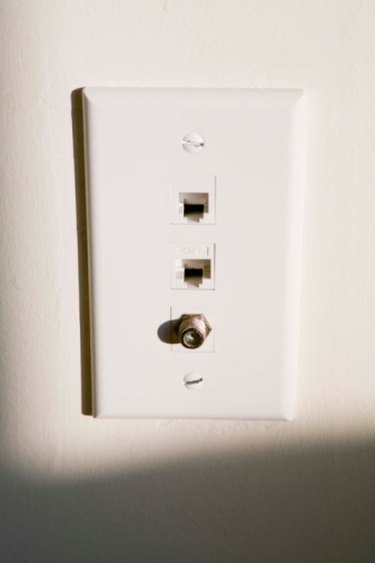
Cable service is provided to a home via a coaxial cable. (Reference1) Reconnecting cable at the pole typically happens when there has been a temporary lapse in service either by choice or by lack of payment. (Reference3) The idea is that all of the inside wiring is still connected and the technician can visit the outside of the house only for the reconnection of services. (Reference2) For a new turn up or a lengthy service issue an inside visit will be needed.
Step 1
Figure out how the area is serviced. (Reference3) Normally there are two methods of connection for TV services from a cable provider. One type is a service wire that runs from the tap through the air to the side of the home and into a junction box called a service demarcation unit (SDU). (Reference2) The second type is a cable that runs underground from the street normally a pedestal in the yard back to the SDU. (Reference1)
Video of the Day
Step 2
Set up your ladder. Using ladder safety is a must when working in the air. Technicians who do not use ladders to reach the reconnect point may use special climbing gear. (Reference3) The covers that go on your feet are called gaffs. The gaffs have straps that fasten around normal boots and they provide spikes on the bottom of your shoes to help balance and hold as you climb. (Reference2) To gaff up a pole you wrap a climbing belt around the pole and fasten it to a special belt that you wear. The reason for the two belt system rather than using one long one is to allow for the insertion of quick release clamps in the event your belt gets stuck and you have to release and gaff back down to the ground unassisted by the belt. (Reference2)
Step 3
Reconnect the cable at the tap using a F-connector and RG6 cable. (Reference4) The tap is a device that sits on the main line and provides a port to plug into. The tap is a big grey or black box that you can see from the ground. If you were able to climb up and look inside you would see the same connectors that are on your wall outlets in your home. (Reference4) Most boxes have four to eight connections within to provide service to the surrounding customers. RG6 is a standard that is used in most cases except where an extra long run is needed. If you plan to have a run over 50 feet then use RG11 to provide protection from fuzzy pictures and fallen lines. (Reference2)
Step 4
Run the cable to the house and mount it using a span clamp cable. Leave a little bit of slack on both sides and attach a clamp to each. (Reference2) Fold the house line back against the main line for about three feet and then insert the clamp. By folding the line back and inserting the clamp you have inserted play into the line. This play will compensate when there are high winds or other things that could pull the cable free. The clamp on the house screws into the house with two extra long mounding screws. Once the screws are in then weatherproof the area with a small amount of clear silicone to retain the weather proofing value of the customer's home. (Reference4)
Step 5
Push the line down the side of the house and mount every few feet with plastic clips. Space the clips unevenly down the side of the house so that it does not interfere with service. This works better if you hide it beside a downspout or other vertical edge of the siding. (Reference2)
Step 6
Slide the cable inside of the weather proofed hole in the SDU. (Reference3) The SDU should still be mounted to the house from a previous install. If it needs secured again then add a few screws through the back of the box into the side of the house. Also check to ensure the previous grounding wire is still attached. A clip is secured to the metal connector and to a wire that runs to a common grounding point such as a cold water pipe. (Reference2) If you leave the ground out it could cause fuzzy pictures and cause a hazard should electricity find its way onto the line and have nowhere to go. (Reference1)
Step 7
Reconnect the cable from inside the house to a splitter in the SDU box.(Reference1) Connect the line that you just installed from the pole at the street to the same splitter. A splitter is nothing more than a passive device that allows for one cable to be connected to many others. (Reference2) Some splitters have one in port and many out ports. The line from the street goes into the in port. Not all splitters have this preference.
Video of the Day